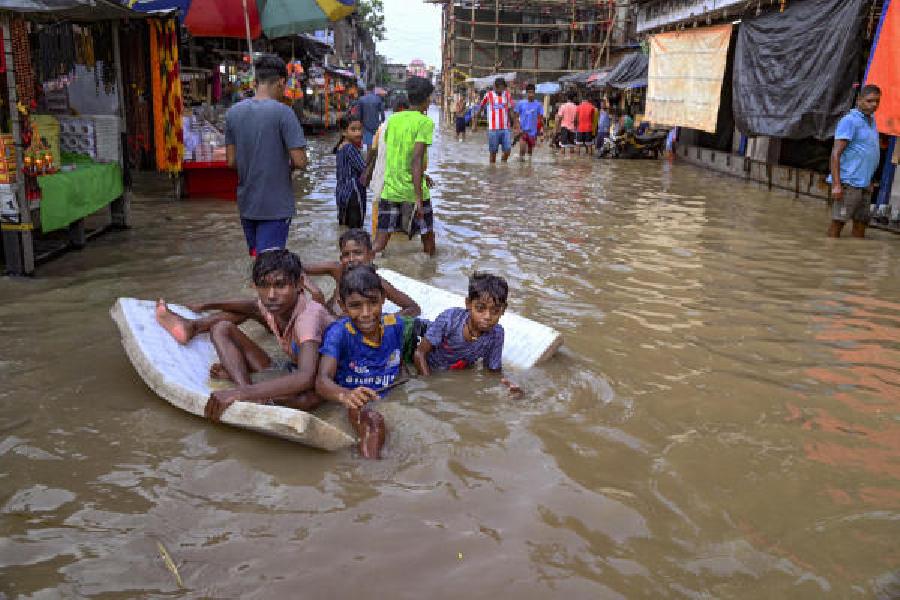Implementing the Ghatal Master Plan — a mega-flood management programme to bring relief to people in low-lying areas around Ghatal in West and East Midnapore — could prove to be a non-starter although the Mamata Banerjee government has promised to fund it in the absence of central funds.
Sources aware of the project told The Telegraph that the project had to overcome a series of hurdles, including state government's hands-off land policy and cash-strapped state coffers, to get commissioned in the near future.
"A few thousand people living near the Shilabati river have to be relocated to implement the project successfully. Moreover, the state needs to spend more than ₹1,000 crore to complete the project. Both appear to be tough for the state,” said a senior state government official.
After the foundation stone for the project was laid in 1982, the first initiative to implement the Ghatal Master Plan was initiated by the erstwhile Left Front government when it prepared a detailed project report and submitted it to the central government in 2009. The foundation stone for the project was laid years after the Mansingh Committee of the central government conceived the plan in 1959.
The Union ministry of Jal Shakti had approved the ₹1,207 crore plan in 2012, but Delhi did not sanction any funds since then as investment clearance and funding pattern clearance was yet to be approved by the ministry.
Chief minister Mamata Banerjee had written a series of letters to Prime Minister Narendra Modi, urging him to take initiatives to clear the proposal in the past few years, but nothing concrete materialised.
“Initially, there was a confusion about the funding pattern.... Finally, the state government had agreed to a 60:40 funding pattern where the state would shoulder 40 per cent of the expenditure. But still the Centre's lackadaisical approach prevented the project from being implemented,” said an official.
Officials in Nabanna said the Centre was never serious about the project as it did not allot enough funds under the Accelerated Irrigation Benefit and Flood Management Programme.
“Under this programme, schemes like the Ghatal Master Plan were supposed to be implemented. But the Centre never allotted more than ₹450 crore under the programme that caters to the entire country. This year also, the Centre allotted ₹440 crore under the programme for the entire country,” said an official.
Senior officials pointed out that the chief minister had announced plans to implement the projects with state's resources since the Centre did not respond to the chief minister's repeated reminders in February this year.
Officials aware of the ground realities said the state government had already taken up some measures to control the floods in Ghatal and its surrounding areas in East and West Midnapore. All these initiatives were part of Ghatal Master Plan.
Before joining the BJP, the leader of the Opposition, Suvendu Adhikari, as the then irrigation minister in the Trinamool-led government, had carried out some projects like the restoration of Palashpai, Durbachuti and Chandreswar canals, sources said.
“But a number of jobs under the master plan were yet to be carried out. Which would be easier said than done given that it would require land and funds,” said a source.
First of all, the state has to dig a canal to join Shilabati river to Chandreshwar canal.
“Digging this 5-6km long canal would require a handsome quantum of land. As the area is densely populated, a number of families have to be relocated,” said an official.
Not only this, the state would have to erect new embankments along the Shilabati river to prevent water from gushing into Ghatal town. But the problem is that thousands of people live in these low-lying areas and none of them are illegal settlers. They live on their own land.
“The state government will try to buy these land parcels directly from the land owners. It is unlikely that the owners will agree to the proposal of the state government as its direct land purchase policy offers only 1.5 times of the current market price while the new land acquisition Act of the Centre offers up to four times of the current market price of the land. Furthermore, the new land acquisition Act offers compensation for the structures set up on the land too,” said an official.
In addition, the state will have to take up several other initiatives like desiltation of Shilabati and its connecting canals, setting up of two pump houses on both the sides of the river.
Besides, several embankments have to be strengthened under the scheme.
“The state government has drawn up a plan to set up a pump house on the bank of the Shilabati river. But the state has to take many other initiatives, for which the government will require to spend more than ₹1,000 crore. Now, the question remains whether the struggling coffers of the Bengal government will be able to shoulder the additional burden,” said a bureaucrat.
Sources aware of the project said that even if the state government completed all the work, it would not be enough to keep Ghatal free from waterlogging due to its topography.
“It has some flat areas known as chatal where waterlogging will occur even if the Ghatal Master Plan is implemented properly. But waterlogging won't be as bad as now, when many wards get under 10-12 feet water,” said an official.










